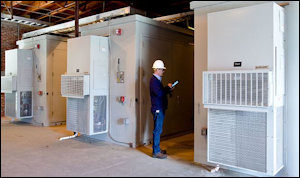by Jane Twitmyer
Virginia has all the tools it needs to build an inexpensive, reliable, clean energy future. We’re not talking about exotic technologies that might become available some day in the future. Solar power, wind power, battery storage, microgrids, energy-efficient buildings and other clean-power technologies are available right now at a cost competitive with fossil fuels and nuclear. The Old Dominion just needs a regulatory structure to match.
Virginia’s energy landscape has changed faster than many thought possible. Electricity-hungry data centers are demanding electricity generated from 100% renewable sources. As projected demand has shifted, Dominion Energy has canceled two planned large, base-load natural gas plants. In their place the company now plans to build 3,600 megawatts of gas-fired “peakers’” designed to back up the promised 5,000 megawatts of solar and solar power when clouds block the sun or there is a lull in the wind.
But the experience of other utilities is showing that even the peaker plants aren’t necessary. Consider the Moss Landing gas-powered plant in California. In 1998 PG&E sold Moss Landing to Duke Energy, which spent $500 million upgrading the plant before selling it to Dynergy. Last year Dynergy retired two super-critical steam units because they were no longer economically competitive. Now, a newly reinvented Moss Landing anticipates becoming an energy storage facility filled with 300 megawatt/1,200 megawatt-hour batteries.
In Vermont, Green Mountain Power has built a system of distributed stored energy. Solar customers pay $15 a month to host a utility-owned and-operated Tesla Powerwall in exchange for backup power. During peak energy days the utility pulls from 500 Tesla Powerwalls as well as energy storage facilities in Rutland and Panton. Vice President Josh Castonguay says these alternatives to gas work as planned this summer when the batteries took the equivalent of 5,000 homes off the grid.
In New Hampshire, Liberty Utilities wants to own and install 1,000 Tesla Powerwalls in the homes of its customers. The five megawatts of aggregated battery capacity would allow Liberty to reduce its load peak, saving an estimated $693,000 a year in transmission costs and potentially offsetting traditional wires upgrades.
Another approach to meeting peak demand is to combine offshore wind with solar. Rooftop solar combined with our extraordinary offshore wind resource can meet all of Virginia’s summer peak demand. Solar’s peak production ends as the wind picks up, and thanks to the sea breeze effect, an offshore wind farm is very productive when electric demand in the region is at its highest.
Virginia’s offshore wind has the potential to generate three times as much net energy as Dominion’s 2017 net energy load with no fuel required. Just the offshore leases acquired by Dominion in 2013 can provide the electricity equivalent of 2.5 nuclear plants. More leases will be available in the future, yet the utility’s 2018 Integrated Resource Plan anticipates building only two “demonstration” windmills on Dominion’s leased waters during the next 15 years. Offshore wind looks like a missed opportunity.
The Virginia coast is located on the Mid Atlantic Bight, the geological formation that runs from Cape Cod to Cape Hatteras. The Bight is the shallow, wide edge of the continental shelf 30 miles, more or less, from shore. Wind speeds on the Bight are higher, blades can be larger, and the “sea breeze effect” generates power during times of high demand onshore.
The Mid-Atlantic Bight has been called the potential “Saudi Arabia of Wind.” Bight wind installations are underway in Rhode Island, Massachusetts, and Maryland. The Governor of New Jersey Governor’s has signed an executive order setting a goal of generating 3,500 megawatts of offshore wind energy by 2030. New York Governor Cuomo has called for developing 2,400 megawatts of offshore wind by 2030, targeting 800 megawatts for this year and next.
The U.S. offshore wind industry will be built. A pipeline of wind projects totals 25.46 gigawatts, including 1.3 gigawatts added last year. Building Offshore Wind means building a whole new industry. Costs will drop rapidly as supply chains and construction capabilities develop. Gov. Ralph Northam’s recent hiring of the international energy consultants BVG Associates to analyze how the state can become a coastal leader for the offshore wind industry is important. The Hampton Roads area is well suited to becoming an offshore wind hub. According to the Natural Resources Defense Council (NRDC), it will bring 4,377 jobs and $641 million economic benefits to the state.
Price has been an issue but onshore support for the new industry changes the pricing picture. Block Island’s wind farm, built only last year without onshore support facilities, cost $244 per megawatt-hour. Recent bids for Vineyard Wind have come in at $74/megawatt hour, demonstrating the financial value of onshore support facilities. In Massachusetts the old whaling port of New Bedford is undergoing a commercial makeover of more than $200 million, including the construction of a marine commerce terminal financed by the state, to prepare for the offshore wind industry.
The clean energy economy is being created around the world. Virginia needs to diversify away from gas as its primary, centrally distributed resource. We all want Virginia’s privately owned utilities to remain profitable, but it will take writing basic new rules to avoid the “death spiral” of declining monopoly utility sales and rising electricity rates. A utility-owned multi-directional grid that can accommodate a multiplicity of solar and wind is proving to be the most reliable and affordable choice for other states, and can be for Virginia, too.
Jane Twitmyer is a member of Renewable Loudoun. She has been a renewable energy consultant and advocate since 2011.



